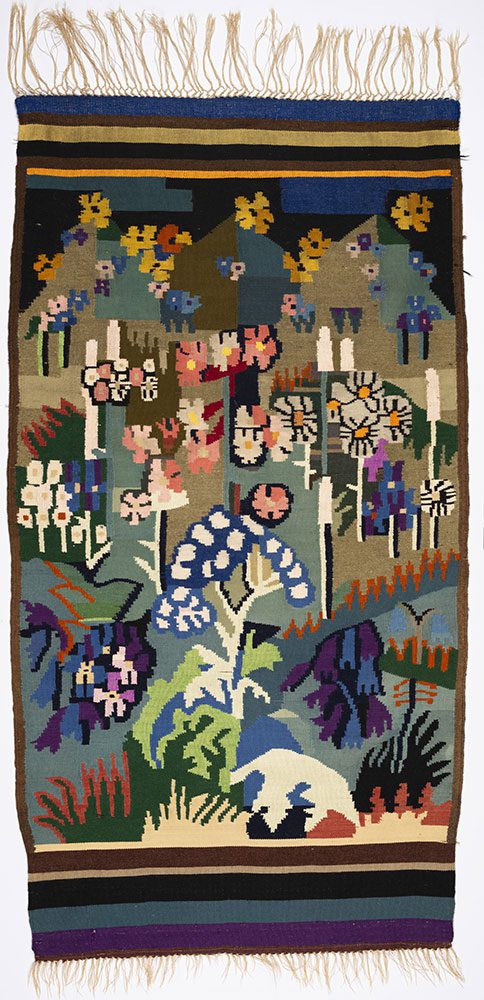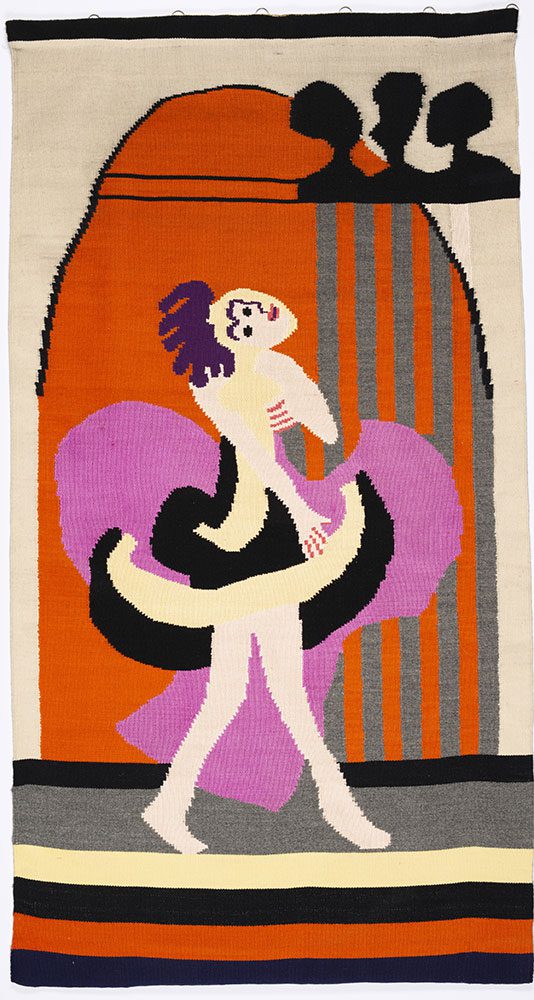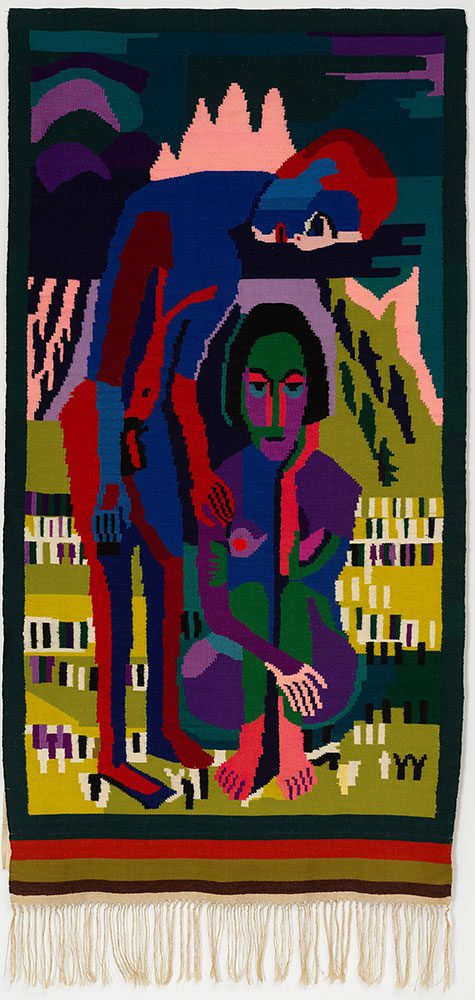PRESENTATION: Lise Gujer-A New Way of Painting
 From 1915, Lise Gujer lived in Clavadel near Davos. In the summer of 1922, she met the Die Brücke* (The Bridge). artist Ernst Ludwig Kirchner in the Swiss climatic health resort of Davos. Shortly after meeting him, she began to produce large-format tapestries based on his designs, which inspired Kirchner as a ‘new way of painting’.
From 1915, Lise Gujer lived in Clavadel near Davos. In the summer of 1922, she met the Die Brücke* (The Bridge). artist Ernst Ludwig Kirchner in the Swiss climatic health resort of Davos. Shortly after meeting him, she began to produce large-format tapestries based on his designs, which inspired Kirchner as a ‘new way of painting’.
By Efi Michalarou
Photo: Brücke-Museum Archive
Lise Gujer’s colorful and artistically complex textiles depict the Swiss mountains with their animals and people. Some carpets are also dedicated to the theme of dance. The close collaboration between Gujer and Kirchner continued until Kirchner’s suicide in June 1938. More than 10 years later, in the early 1950s, Gujer continued her work on the loom, moving away from Kirchner’s preparatory drawings and creating new variations on previous motifs. The exhibition “Lise Gujer. A New Way of Painting. In Dialogue with Ernst Ludwig Kirchner” shows more than twenty of her tapestries as well as numerous preparatory drawings by Kirchner. The aim of this exhibition is to highlight Gujer’s authorship and thus recognise her place in the history of Expressionism. After more than 20 years, this is the first presentation dedicated to the work of the long-forgotten textile artist. The presentation is complemented by an educational room in which weaving techniques and materials are presented. An extensive accompanying programme opens up other perspectives and approaches to the themes of the exhibition. For example, the artists’ group “Traces” invites visitors to take part in collective weaving. Lise Gujer was the daughter of Zurich furrier and politician Rudolf Gujer and Elise Müller. While in Davos, she met the artist Ernst Ludwig Kirchner and his partner Erna Schilling. Kirchner’s painting influenced her motifs, and the artist, who had been creating designs for textile works since his time in Dresden, asked her to execute his templates as woven tapestries. For this, Lise Gujer used linen for the warp threads and colored wool threads for the weft. From 1924 onwards, she was able to regularly produce works for Kirchner that met his high standards for color. Their artistic collaboration lasted for sixteen years. Two years after Kirchner’s death, in 1940, she purchased the house “Kauf Gruoba” in the Sertig Valley and furnished it with furniture and artworks from Kirchner’s estate. After a hiatus of several years, Lise Gujer resumed her artistic work in 1951. She created tapestry works that once again incorporated motifs from Kirchner’s creations, with some produced in multiple editions. In 1925, Lise Gujer presented some of her works at the “Exposition internationale des arts décoratifs et industriels modernes” in Paris. In 1968, her private collection, which included designs by Kirchner, was auctioned in Bern by the Galerie Kornfeld and Klipstein. Ernst Ludwig Kirchner was a German painter and printmaker who was one of the leaders of a group of Expressionist artists known as Die Brücke. His mature style was highly personal and notable for its psychological tension and eroticism. In 1898 Kirchner was impressed by the graphic art of the German late Gothic artists, especially Albrecht Dürer, whose influence on Kirchner was lifelong. But exposure to the Jugendstil movement and the dynamic art of the Norwegian Expressionist painter Edvard Munch led Kirchner to simplify his forms and brighten his colors, a development aided by his discovery in 1904 of African and Polynesian art. Between 1901 and 1905, Kirchner studied architecture intermittently in Dresden, Germany. However, he continued to be obsessed with painting, and in 1905 he founded Die Brücke* with Erich Heckel and Karl Schmidt-Rottluff. Other artists, including Emil Nolde, subsequently joined the group. For Kirchner, art was an immediate, powerful translation of inner conflict into visual terms. He cited the emotive work of Vincent van Gogh and Munch as artistic touchstones. In 1911 the members of Die Brücke moved to Berlin, where Kirchner produced masterful woodcuts for Der Sturm, Germany’s leading avant-garde periodical before World War I. His illustrations for Adelbert von Chamisso’s novel “Peter Schlemihls wundersame Geschichte” (1915) and for the poem “Umbra Vitae” (1924) by the Expressionist poet Georg Heym are considered to be among the finest engravings of the 20th century. After a mental and physical breakdown in 1915, Kirchner moved to Switzerland. His late landscapes are often allegorical, showing human beings unencumbered by civilization and at peace with nature. Kirchner endured long periods of depression, and after the Nazis declared his work “degenerate” in 1937, he committed suicide.
* Progenitors of the movement later known as German Expressionism, Die Brücke formed in Dresden in 1905 as a bohemian collective of artists in staunch opposition to the older, established bourgeois social order of Germany. Their art confronted feelings of alienation from the modern world by reaching back to pre-academic forms of expression including woodcut prints, carved wooden sculptures, and “primitive” modes of painting. This quest for authentic emotion led to an expressive style characterized by heightened color and a direct, simplified approach to form.
Photo Left: Lise Gujer, Farmer Couple, after 1952, after a design of the tapestry Life von Ernst Ludwig Kirchner, Brücke- Museum, Karl und Emy Schmidt-Rottluff Stiftung © Es- tate Lise Gujer, photo: BKM/Thomas Strub. Photo Right: Lise Gujer, Flower Tapestry, 1938, after a design by Ernst Ludwig Kirchner from 1938, private collection Zu- rich © Estate Lise Gujer, photo: BKM/Thomas Strub
Info: Curator” Lisa Marei Schmidt, Assistant Curator: Luna Weis & Luisa Fricker, Brücke-Museum, Bussardsteig 9, Berlin, Germany, Duration: 7/12/2024-16/3/2025, Days & Hours: Mon & Wed-sun 11:00-17:00, www.bruecke-museum.de/




